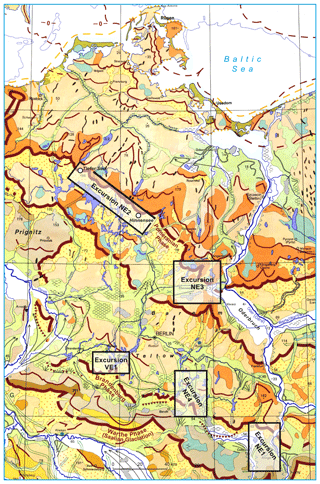Preface: Quaternary landscapes, sediments and geoarchives in northeastern Germany – a guidebook to field excursions
This special issue is a guidebook for five field excursions in NE Germany scheduled for the DEUQUA 2022 conference in Potsdam entitled “Connecting Geoarchives”. These excursions encompass a variety of different topics including quaternary geology, geomorphology, geoarchaeology and geoarchive monitoring. Four of these excursions will introduce different regions in the state of Brandenburg, while one will lead to the state of Mecklenburg-Vorpommern. Two excursions will present and discuss ice dynamics, geomorphological features and dating in the southwestern sector and southern margin of the maximum ice advance during the Weichselian glaciation. One has a focus on geomorphological and periglacial features and cultural heritage aspects in the area around Potsdam. Finally, two contributions will address more specific topics including new geoarchaeological findings in the mining region of Lower Lusatia and field monitoring for lake sedimentation and tree growth to trace climate signal transfer into these geoarchives. The target regions of the five field excursions are indicated on the geological map (Fig. 1).

Figure 1Location of the areas of the five field excursions presented in this volume. Background map is cut out and modified from the map Die nordischen Vereisungen in Mitteleuropa (Liedtke, 1981).
Brandenburg is a classical region for Quaternary research because its geology is dominated by a large variation in different sediment types deposited during the succession of glaciations in the Pleistocene (Stackebrandt, 2018; Stackebrandt and Franke, 2015; Stackebrandt and Manhenke, 2004). These glaciations also shaped the landscape, and the margins of the Scandinavian Ice Sheet (SIS) at its largest extent were located in Brandenburg several times during the last 300 000 years. A striking piece of heritage of these ice advances is, for example, the Weichselian end moraine complexes. Since the first descriptions of these morphological remnants of the ice advances (e.g. Berendt, 1887), more than a century of research has revealed an increasing understanding of the glacial and postglacial landscape evolution. However, due to difficulties in dating glacial deposits and landforms, several questions remained unsolved. Only in the last decade with new methodological developments, for example, in cosmogenic nuclide and luminescence dating, has Quaternary research experienced a new boost, stimulating lively discussion. Based on these methodological developments, new concepts about the ice dynamics, especially during the last glaciation in the Brandenburg region, are discussed that reveal a larger complexity of the dynamics of the SIS than previously assumed (e.g. Böse et al., 2022). In addition to the progress in classical Quaternary research, new developments in the application of geoarchives in these Quaternary landscapes open new perspectives for also reconstructing the postglacial climate and environment evolution in the region, including the increasing role of humans in shaping the landscape. This volume combines these aspects with novel approaches in classical Quaternary research.
The ice margin of the maximum extent of the SIS during the Weichselian glaciation, known as the Brandenburg phase, is one of the focal points in this volume and target area of two field excursions. Furthermore, the Telegrafenberg, location of the host of the DEUQUA 2022, the GFZ German Research Centre for Geosciences, is also part of the morainic complex of the Brandenburg phase.
The first excursion to this morainic complex in the vicinity of Potsdam is a guide through the region around the River Havel waters of lakes Templin and Schwielow (Diekmann et al., 2022) and will present local ice dynamics during the maximum ice advance as well as deglaciation and glacio-fluvial processes. In addition, cultural aspects will be also addressed since Potsdam and its surrounding areas were declared a UNESCO World Heritage Site in 1990.
The other field excursion presenting sites formed during the Brandenburg phase leads to the southeast of Berlin, an area where the SIS reached its furthest southern extent during the last glaciation (Juschus et al., 2022). In this region meltwater processes during the deglaciation played an important role in shaping the landscape and thus are in the focus of this field excursion. In addition, the final shaping of the landscape during the Holocene will also be shown and discussed.
The third chapter provides an introduction for a field excursion in the classical region of Quaternary research in northern Brandenburg and especially the Eberswalde–Chorin area (Lüthgens and Hardt, 2022). This region was shaped by the younger Pomeranian ice advance. Dating glacial sediments and terminal moraines has been a crucial challenge in Quaternary research (Hardt and Böse, 2018), and new developments in dating techniques that have led to new concepts of ice dynamics in the southwestern sector of the SIS (Lüthgens and Böse, 2011) will be discussed.
The fourth chapter also introduces a field excursion in the region of the Pomeranian terminal moraines but further to the west in Mecklenburg and with a different thematic focus (Brauer et al., 2022). Two long-term monitoring projects on different geoarchives are presented. As part of the Helmholtz TERrestrial ENvironmental Observatories (TERENO) infrastructure initiative, a lake and a tree-ring observatory have been in operation for about a decade (Heinrich et al., 2018) with the aim of tracing climate signal transfer into these archives of past climate and environmental variability with seasonal resolution. The instrumental setup and monitoring data are presented in this chapter.
The fifth chapter guides the reader to a region in Brandenburg south of the influence of the Weichselian glaciation (Hirsch et al., 2022). In Lower Lusatia, opencast lignite mines provide unique insights into human-induced environmental changes and thus add this increasingly important aspect to our understanding of Quaternary landscape dynamics. The focus of this chapter is on remains of historical charcoal production and their potential for landscape change.




